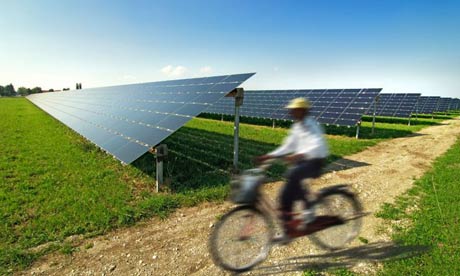
How Africa's desert sun can bring
Europe power
A £5bn solar power plan, backed by
a Jordanian prince, could provide the EU with a sixth
of its electricity needs - and cut carbon emissions
Dec 2, 2007 - The Observer
 |
|
Solar panels like these near
Munich could capture heat in areas of the Mediterranean
under the plan proposed by Prince Hassan bin
Talal. Photograph: Alamy
|
Europe is considering plans to spend more than £5bn
on a string of giant solar power stations along the
Mediterranean desert shores of northern Africa and
the Middle East.
More than a hundred of the generators, each fitted
with thousands of huge mirrors, would generate electricity
to be transmitted by undersea cable to Europe and
then distributed across the continent to European
Union member nations, including Britain.
Billions of watts of power could be generated this
way, enough to provide Europe with a sixth of its
electricity needs and to allow it to make significant
cuts in its carbon emissions. At the same time, the
stations would be used as desalination plants to provide
desert countries with desperately needed supplies
of fresh water.
Last week Prince Hassan bin Talal of Jordan presented
details of the scheme - named Desertec - to the European
Parliament. 'Countries with deserts, countries with
high energy demand, and countries with technology
competence must co-operate,' he told MEPs.
The project has been developed by the Trans-Mediterranean
Renewable Energy Corporation and is supported by engineers
and politicians in Europe as well as Morocco, Algeria,
Libya, Jordan and other nations in the Middle East
and Africa.
Europe would provide initial funds for developing
the solar technology that will be needed to run plants
as well as money for constructing prototype stations.
After that, banks and financial institutions, as well
as national governments, would take over the construction
programme, which could cost more than £200bn over
the next 30 years.
'We don't make enough use of deserts,' said physicist
Gerhard Knies, co-founder of the scheme. 'The sun
beats down on them mercilessly during the day and
heats the ground to tremendous temperatures. Then
at night that heat is radiated back into the atmosphere.
In other words, it is completely wasted. We need to
stop that waste and exploit the vast amounts of energy
that the sun beams down to us.'
Scientists estimate that sunlight could provide
10,000 times the amount of energy needed to fulfil
humanity's current energy needs. Transforming that
solar radiation into a form to be exploited by humanity
is difficult, however.
One solution proposed by the scheme's engineers is
to use large areas of land on which to construct their
solar plants. In Europe, land is costly. But in nations
such as Morocco, Algeria, and Libya it is cheap, mainly
because they are scorched by the sun. The project
aims to exploit that cheap land by use of a technique
known as 'concentrating solar power'.
A CSP station consists of banks of several hundred
giant mirrors that cover large areas of land, around
a square kilometre. Each mirror's position can be
carefully controlled to focus the sun's rays onto
a central metal pillar that is filled with water.
Prototype stations using this technique have already
been tested in Spain and Algeria.
Once the sun's rays are focused on the pillar, temperatures
inside start to soar to 800C. The water inside the
pillar is vaporised into superhot steam which is channelled
off and used to drive turbines which in turn generate
electricity. 'It is proven technology,' added Knies.
'We have shown it works in our test plants.'
Only small stations have been tested, but soon plants
capable of generating 100 megawatts of power could
be built, enough to provide the needs of a town. The
Desertec project envisages a ring of a thousand of
these stations being built along the coast of northern
Africa and round into the Mediterranean coast of the
Middle East. In this way up to 100 billion watts of
power could be generated: two thirds of it would be
kept for local needs, the rest - around 30 billion
watts - would be exported to Europe.
An idea of how much power this represents is revealed
through Britain's electricity generating capacity,
which totals 12 billion watts.
But there is an added twist to the system. The superheated
steam, after it has driven the plant's turbines, would
then be piped through tanks of sea water which would
boil and evaporate. Steam from the sea water would
piped away and condensed and stored as fresh water.
'Essentially you get electricity and fresh water,'
said Knies. 'The latter is going to be crucial for
developing countries round the southern Mediterranean
and in north Africa. Their populations are rising
rapidly, but they have limited supplies of fresh water.
Our solar power plants will not only generate electricity
that they can sell to Europe, they will supply drinkable
water that will sustain their thirsty populations.'
There are drawbacks, however. At present electricity
generated this way would cost around 15-20 eurocents
(11 to 14p) a kilowatt-hour - almost twice the cost
of power generated by coal. At such prices, few nations
would be tempted to switch to solar. 'Unless it is
extremely cheap, it won't stop people using easy-to-get
fossil fuels,' John Gibbins, an energy engineer at
Imperial College London, told Nature magazine last
week.
However, Desertec's backers say improvements over
the next decade should bring the cost of power from
its plants to less than 10 eurocents a kilowatt-hour,
making it competitive with traditionally generated
power.
Other critics say the the plants would be built in
several unstable states which could cut their supplies
to Europe. Again, Knies dismisses the danger. 'It's
not like oil. Solar power is gone once it hits your
mirrors. It would simply be lost income.' The European
Parliament has asked Desertec to propose short-term
demonstration projects.

|